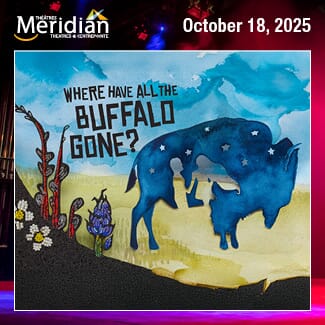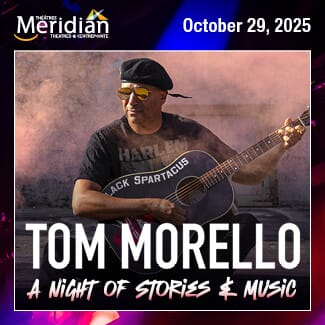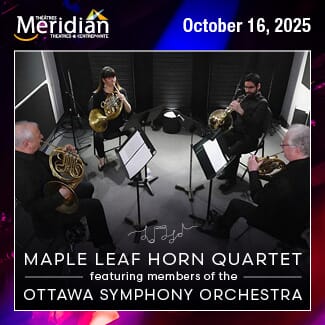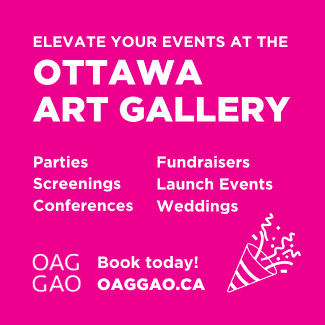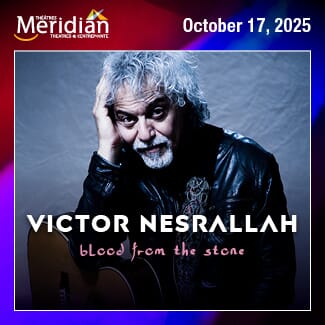By Sandra G.
Pasapkedjiwanong is a two-person exhibition of work by Mary Anne Barkhouse and Olivia Whetung, at the Royal Canadian Art Academy until Nov. 24. It is an exhibition with rich, evocative and powerful stories.
The gallery is located on the second floor of The Royal Canadian Geographic Society which overlooks the Ottawa River. When I visited the gallery, the doors to the balcony were open and I could see and hear the Rideau Falls. The compelling works are amplified by the location, calling attention to both the title, Pasapkedjiwanong, which means “the river that runs between the rocks,” and to the dam complex which regulates water flow. In addition to the dam, it is fitting how colonial powers are evident on either side of the location: on the east is the French embassy, and in the west up river, the British embassy.
Whetung has two sculptures in the exhibition. In Eulogy, scaled-down canal gates let the river—made sparkling and seductive by strands of thousands of beads—spill onto fabric covering the carpeted floor. A silver beaver sits in the river with an open notebook and four ducks appear iridescent as they attend to its reading of Basil Johnston’s story of creation. Eulogy addresses the loss of diversity and habitat caused by river dams. The grouping of the beaver and the ducks offer the possibility of listening and affirming the importance of teachings about the connections of all beings.

“Eulogy” by Olivia Whetung in Pasapkedjiwanong exhibit. Photo by Sandra G.
Her other floor sculpture, Wake, features a beaver skull from which strands of twisted beads become waves. Beavers’ work in filtering water and creating wetlands is acknowledged. Multiple meanings of wake are suggested here: the wake of the water created from the beaver swimming; wake, as in keeping watch over the body of the deceased; and wake, as in rousing from sleep: wake up!
Whetung’s sculptures are well-crafted stories. The beading is exquisite in its use of different sizes of beads and tonal shifts; it conveys a sense of patient, gathered time. Her work considers the creatures that have shaped our world and also calls out how colonial reshaping of our ecosystems threatens the diversity and health of our waterways.
Like Whetung, Barkhouse entwines environmental concerns and Indigenous cultures with the use of animal imagery. She also incorporates family history in the two sculptures and three tapestries in the show. Feast includes a bronze dog seated expectantly near a table on which there are a few cans of salmon. The cans, fashioned from cloth, have cyanotypes on the lids and depict the artist and various family members engaged in fishing and canning salmon. Water is considered as a source of food but the modesty of the table, the dog, and the images suggest an exchange between water and creatures, human and non-human.
Her other sculpture, Succession II, also references resource extraction: a chainsaw, cast in clay, sits on a slice of cut wood. The chainsaw, a Pioneer, is a decades old model, similar to one Barkhouse’s uncles used in Nova Scotia. The wood is a slice from a tree cut by the same uncles, its surface scarred from the blade. Mosses gather around the saw, a bronze cast tree rises from the wood, a red cardinal in its branches. Succession II acknowledges the history of resource extraction but suggests a more regenerative approach.

Mary Anne Barkhouse’s “Monarchs and Other Wildlife” in Pasapkedjiwanong exhibit. Photo by Sandra G.
Barkhouse’s tapestries are made digitally, creating a habitat using personal and collected images which are then manufactured in cloth. Creatures of all sorts appear in Monarchs and Other Wildlife, including a wolf, a turtle, a unicorn, a moose being lifted on a crane, and Queen Victoria. Our colonial past is acknowledged with the Parliament Buildings in the background, but there’s a different hierarchy, one where humans, including royalty, are conjoined in a harmonious and humorous weave.
Outside the Rideau River continues to cascade into the Ottawa River. Pasapkedjiwanong insists care be given to the river and that we listen to the beaver in order to sustain all the creatures in our waterways. It’s an exhibition powerful for its message and for its thoughtful, well crafted, evocative works.
Pasapkedjiwanong is on until Sunday, Nov. 24, 2024 at the Royal Canadian Academy of Arts, located on the second floor of the Royal Canadian Geographic Society building at 50 Sussex Dr. in Ottawa. The gallery is open from 10 am to 4 pm (closed on Saturdays).
Sandra G is an artist who lives in Ottawa, which is on the unceded, unsurrendered Territory of the Anishinabe Algonquin Nation. She frequently paddles in the Ottawa River.







